Former PECS user and environmental artist James Owen Thomas, aged just 20, has several exhibitions and commissions already under his belt.
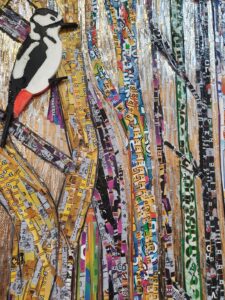
Within the Woodland
I took a trip to Farley’s House & Gallery in Chiddingly recently to see James’ current exhibition ‘From Waste to Wall’ – a series of collages created from numerous pieces of used scratch cards and other recycled materials. The pieces are incredible, intricately detailed, making the viewer see something new each time you look at them. Some shine and reflect light, some are in relief, all of them draw you in and want to make you press your face as close as possible to see the detail.
Recent commissions
Last year James was commissioned by Caudwell Children, a charity for disabled children and their families, to create a unique and ambitious work-of-art to raise both funds and awareness for their services. The piece, which will soon be presented to the charity, depicts its history in collage form.
James has also recently become an ambassador for The Tree Council. Earlier this year they asked him to submit some design ideas for their ‘Young Tree Champions’ ambassador t-shirts. They are including some of his tree collage artwork designs at their forthcoming online festival event this month and have used some of his tree art on a postcard.
I caught up with James to talk about his early life and what inspired him to become an environmental artist.
Early Life
Louise: You have a diagnosis of autism, how do you think that has shaped your life?
James: I was diagnosed with autism when I was 3 ½ years old. I am told that I found it difficult being around other people and I had very little speech when I first started school. As I got older, I have learned to think of my autism less as a disability and more of another kind of ability.
Louise: What age were you when you started using PECS?
James: I started using PECS when I began school at the age of 4.
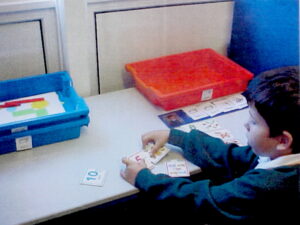
James: The teachers used PECS and visual timetables to help with my communication and understanding of others. I received speech and language therapy for the first four years of my education.
Louise: You don’t need to use PECS anymore, when did you last use it?
James: A long time ago when I was about 8. I only used pictures for communication at special schools I attended.
Louise: What was the main advantage to you of being a PECS user?
James: I loved pictures. From an early age it was clear that I found pictures very calming. I felt reassured knowing that I could use a picture to ask for something, rather than become angry and frustrated because I couldn’t always make myself understood.
Louise: In what ways did being a PECS user make life easier for you?
James: Too much noise, too many people, too much light, too much of anything really could lead to anxiety and stress for me. It was reassuring to know that a picture would tell me which activity I was going to do next. I didn’t follow people’s emotions so learning about expressions on people’s faces from pictures was the way I was helped to understand whether someone felt happy, sad, angry, surprised, embarrassed, frustrated etc.
Louise: What can you remember about being taught how to use PECS?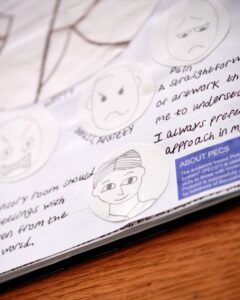
James: Very little I’m afraid as it was long ago but I do remember receiving praise for good behaviour using pictures.
Louise: How far did you get through the phases of PECS, did you use it for commenting and more advanced concepts?
James: I was lucky that in time I started saying words again – some were words that I had initially lost that gradually came back. I was told I developed echolalic speech, so I used to repeat certain words and short phrases over and over again.
Louise: Were your family on board with using PECS or were they concerned that it might stop you from developing speech?
James: My mother was relieved that I was receiving speech and language therapy and she was given regular reports about my progress.
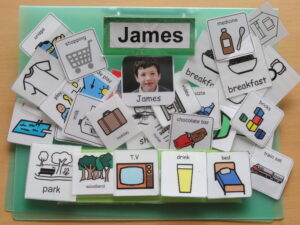
James: I was in a small class of fewer than 10 children when I was first at school and I think that we all used pictures for communication in some way.
Louise: Were you a PECS user in the community – outside of school and the family home, in shops and leisure activities for example?
James: Mainly at school and home, but I think also at my first art group when I was 5 as it was quite specialised and linked with my school.
Louise: As a former PECS user, is there anything that you would like the parents of, or anyone working with an autistic child to know?
James: I think my mother would probably say to never give up! There is a lot of research about ways in which to help children with autism. Pictures can really be useful when you do not have language skills. I think it takes practice too and perseverance.
Becoming An Established Artist
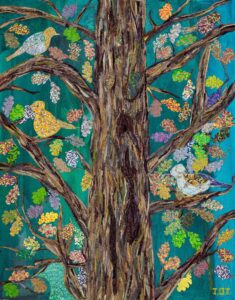
Tree of Life
Louise: You are now an established artist, was if difficult to make the transition from it being just an interest to it being your career?
James: It takes time to make contacts but I have been lucky to have received support and advice from some very experienced artists. I have been shown new techniques in photography, taught new computer skills and learned different forms of art like printmaking with them in their studios.
Bradford School of Art (where I previously took my extended diploma in art and design) now promotes my art through social media and on their website. One of my end of year projects had been creating a space in the art studio there based on my memories of a sensory room. When I was younger I developed special interests and enjoyed collecting things like bus and train tickets. This then changed to collecting colourful National Lottery scratch cards and I gradually realised that I could create something quite unique with them. I have strong feelings about protecting our environment so I like to recycle whatever I can into my artwork. People seem to like reading about this and how pictures have been so important to me in my life as there have been articles printed in the local press about my form of environmental art.
Inspiration
Louise: Who or what inspires your art?
James: The biggest inspiration of all is being out in nature. Long before lockdown I was always going on walks in the countryside, so I just continued doing this. I’m not someone who wants a lot of company so just giving myself quiet time to look at trees and flowers, birds and wildlife of all types gives me all the ideas I need for new collages. When I walk I notice patterns of clouds and the bright colours of spring and summer flowers, autumn leaves and winter snow scenes. I like taking photographs to remind myself of what I see on my walks.
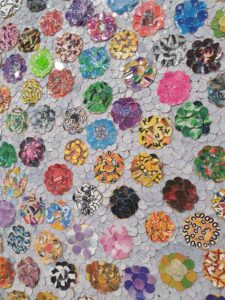
Bejewelled
Louise: What techniques do you use to create your art?
James: I started tearing pieces of discarded scratch cards when I was about 14 and then putting them back together again in a mosaic-type way. My first collage was an abstract called “Abbey Ruins” and people still like it as it’s quite surreal.
Sometimes I need to be much more precise when cutting pieces to size. I do this with buildings when I want bricks to be more or less the same by cutting out symbols of £50 notes for example. There may be layers and layers to give texture. I carry on until I feel happy with the look I am creating.
I also hole punch pieces of recycled papers for my artwork as I like the pointillist style which uses many different dots of colour to create special effects and patterns.
I have a distinctive style that represents my main interests. I include what is most important to me in my ideas for collage: nature, places visited and special occasions. Visitors to my exhibitions appreciate the environmental aspect of being able to turn unwanted material into something creative and unique. I’ve been told that my work is “truly inspiring and thought provoking” as people understand that I create art with a message.
By Louise Hotchkiss
© Pyramid Educational Consultants UK Ltd
